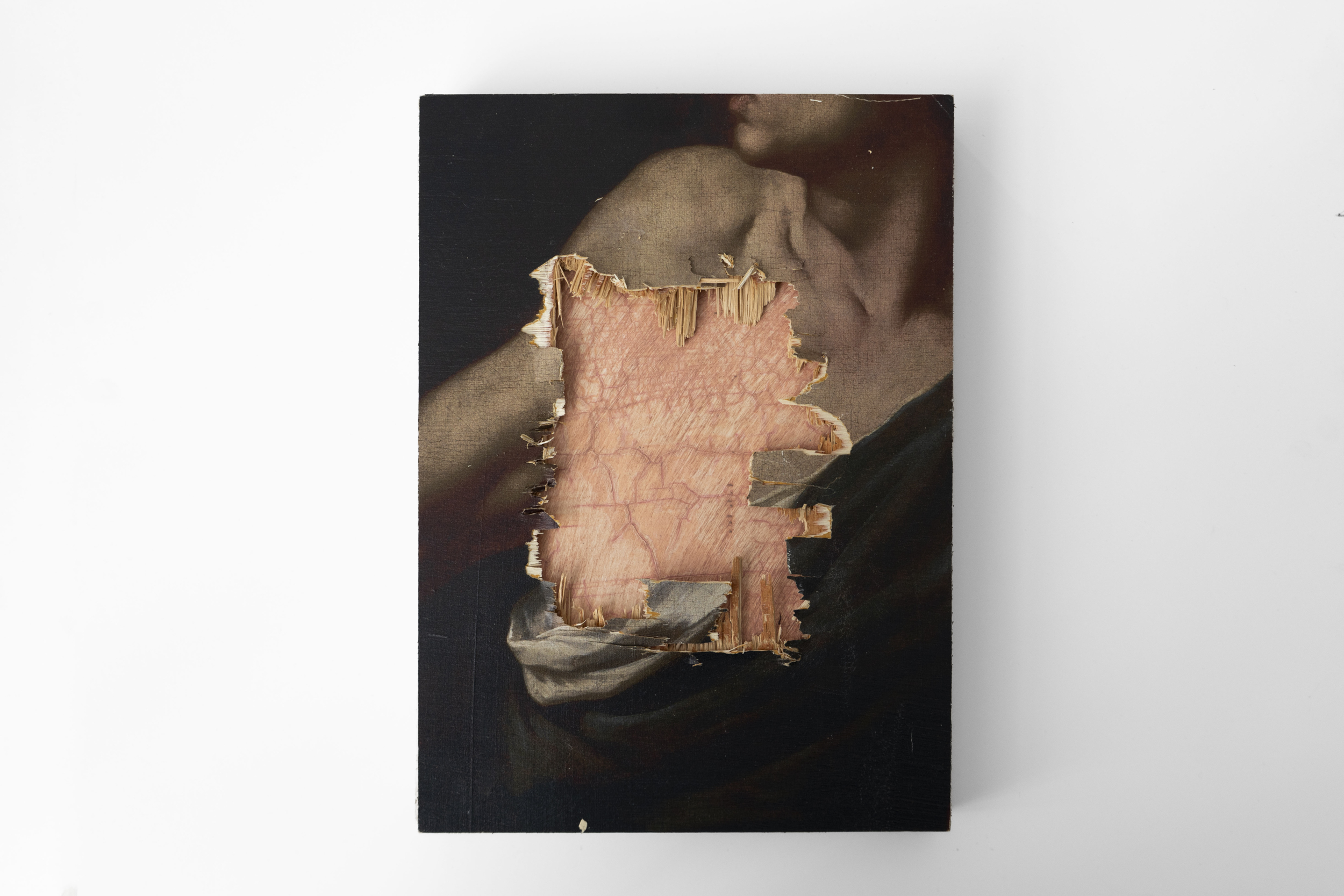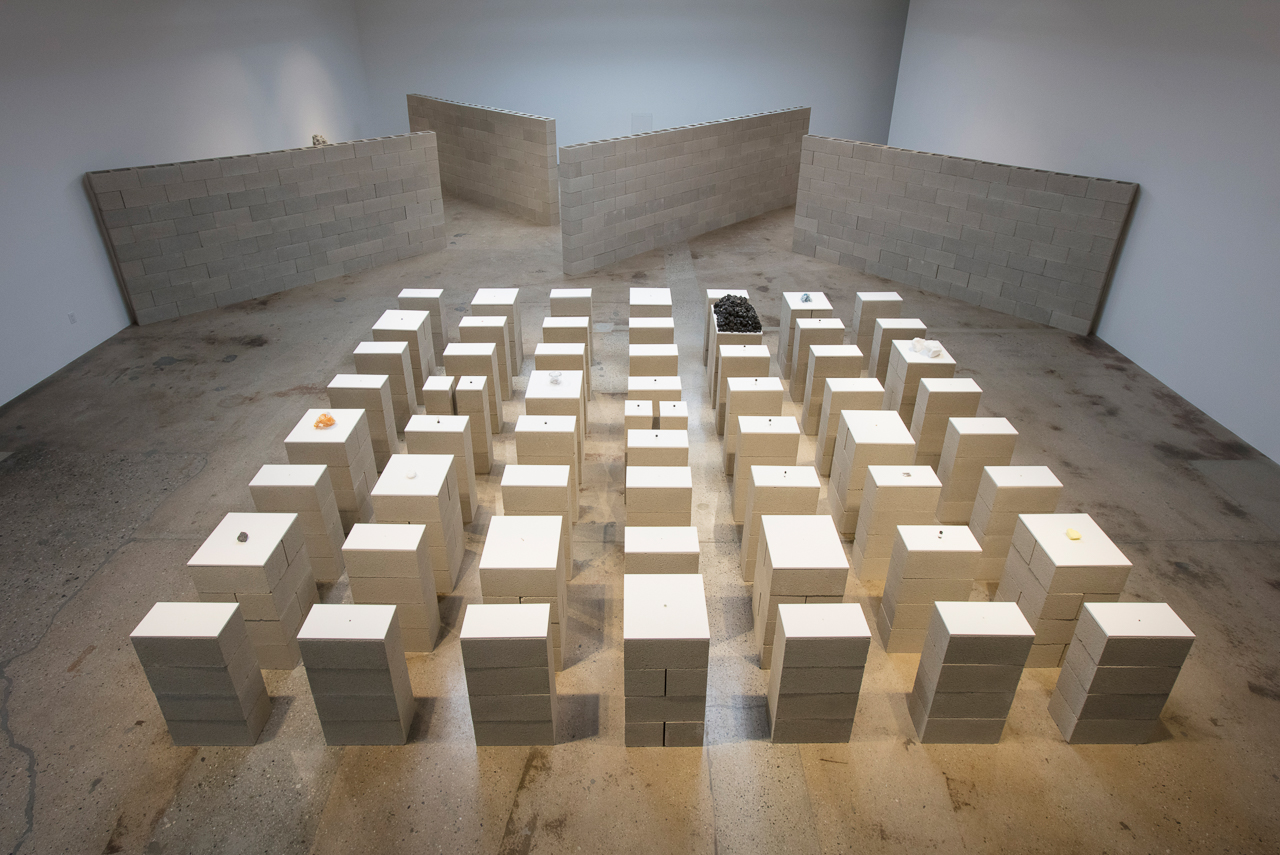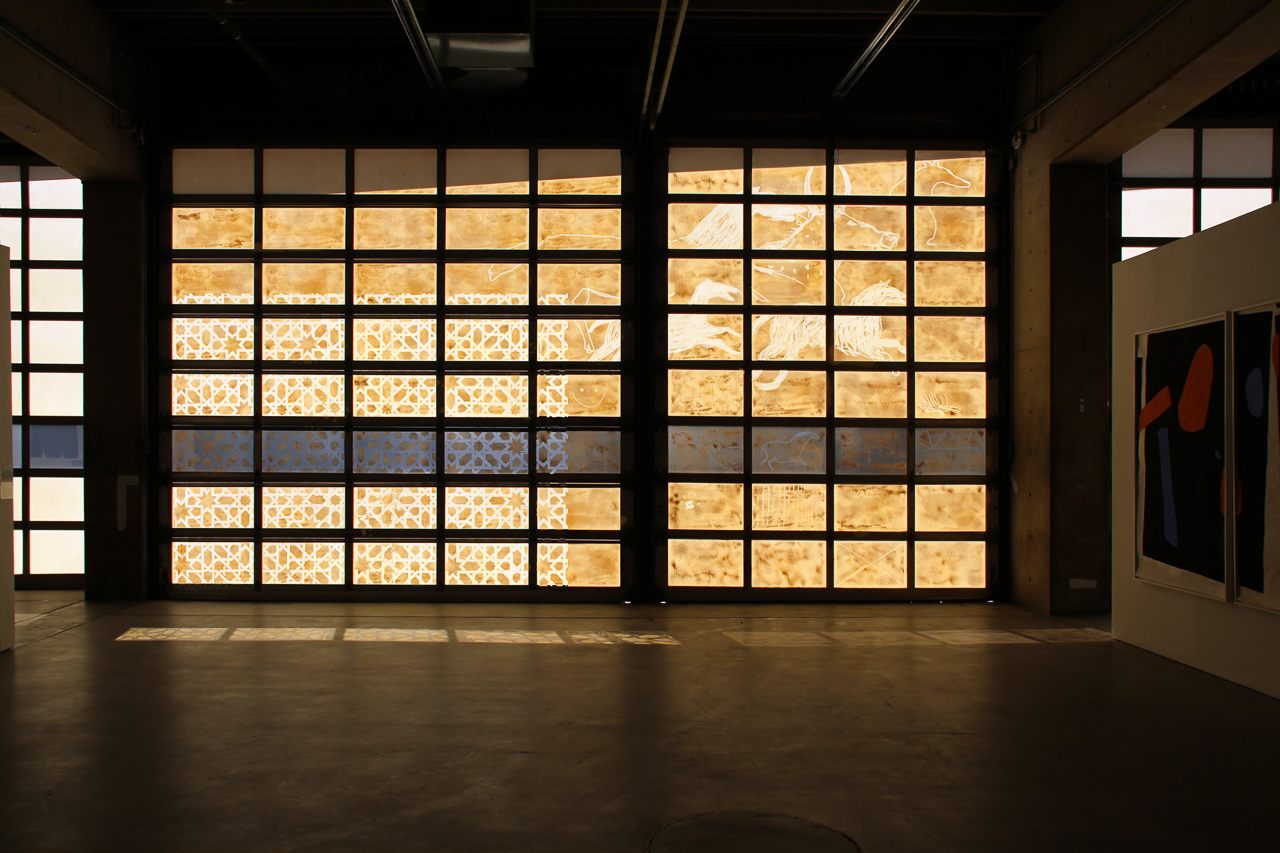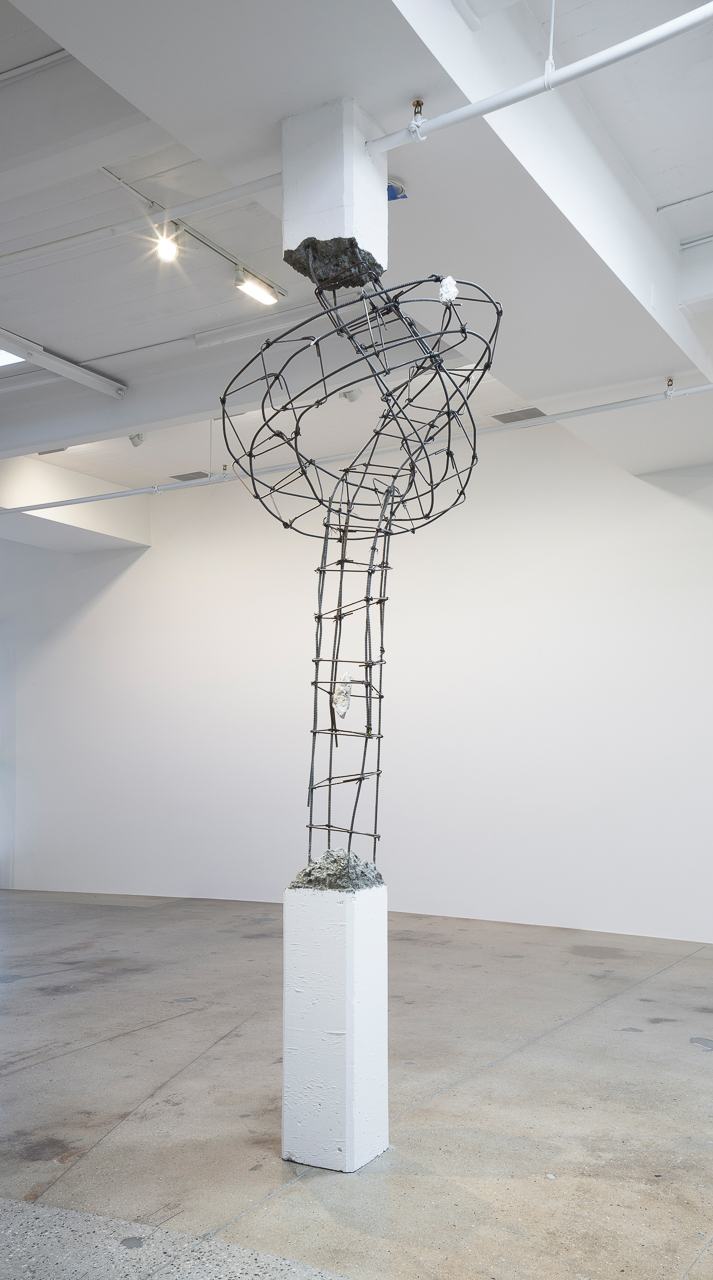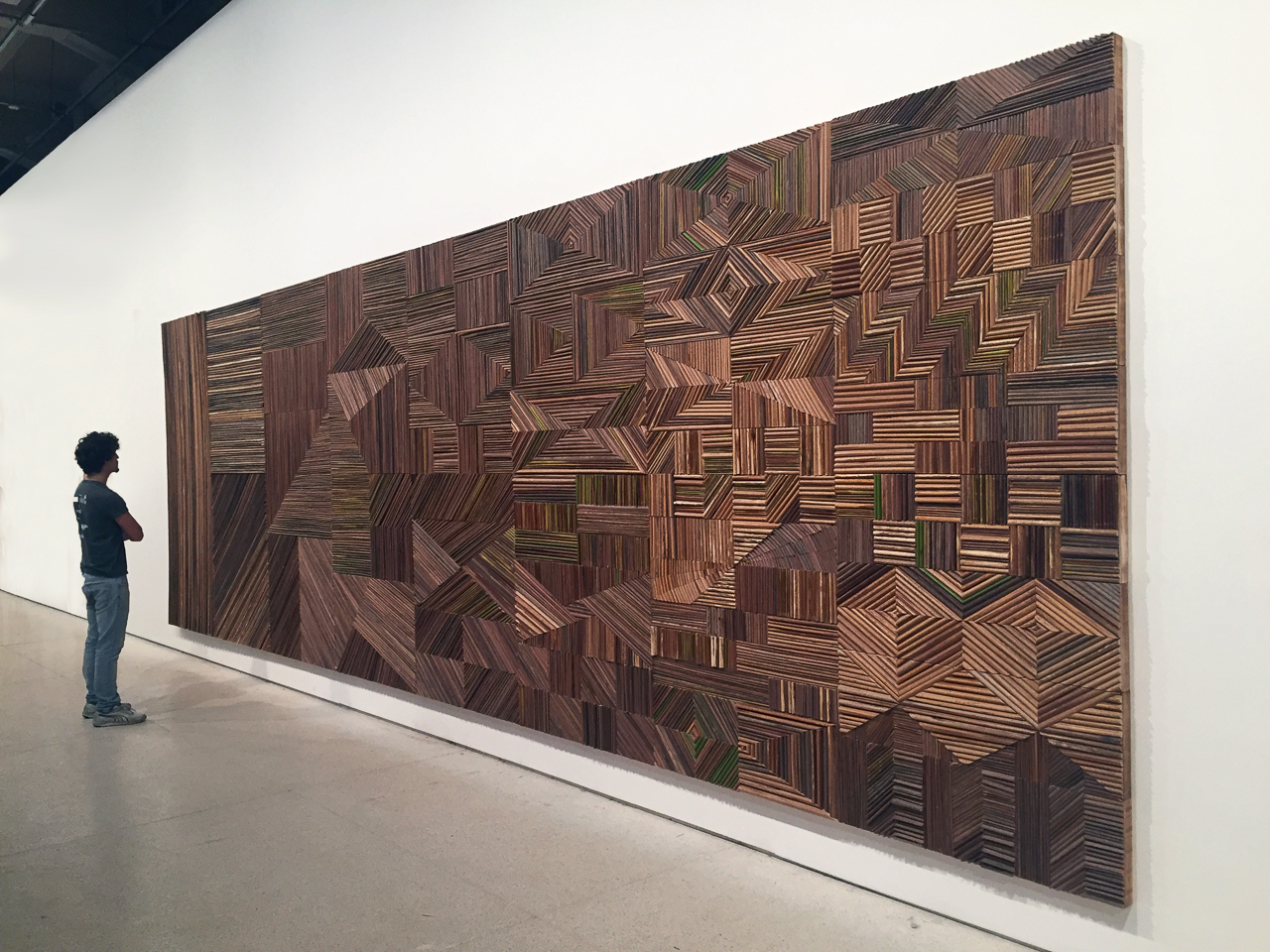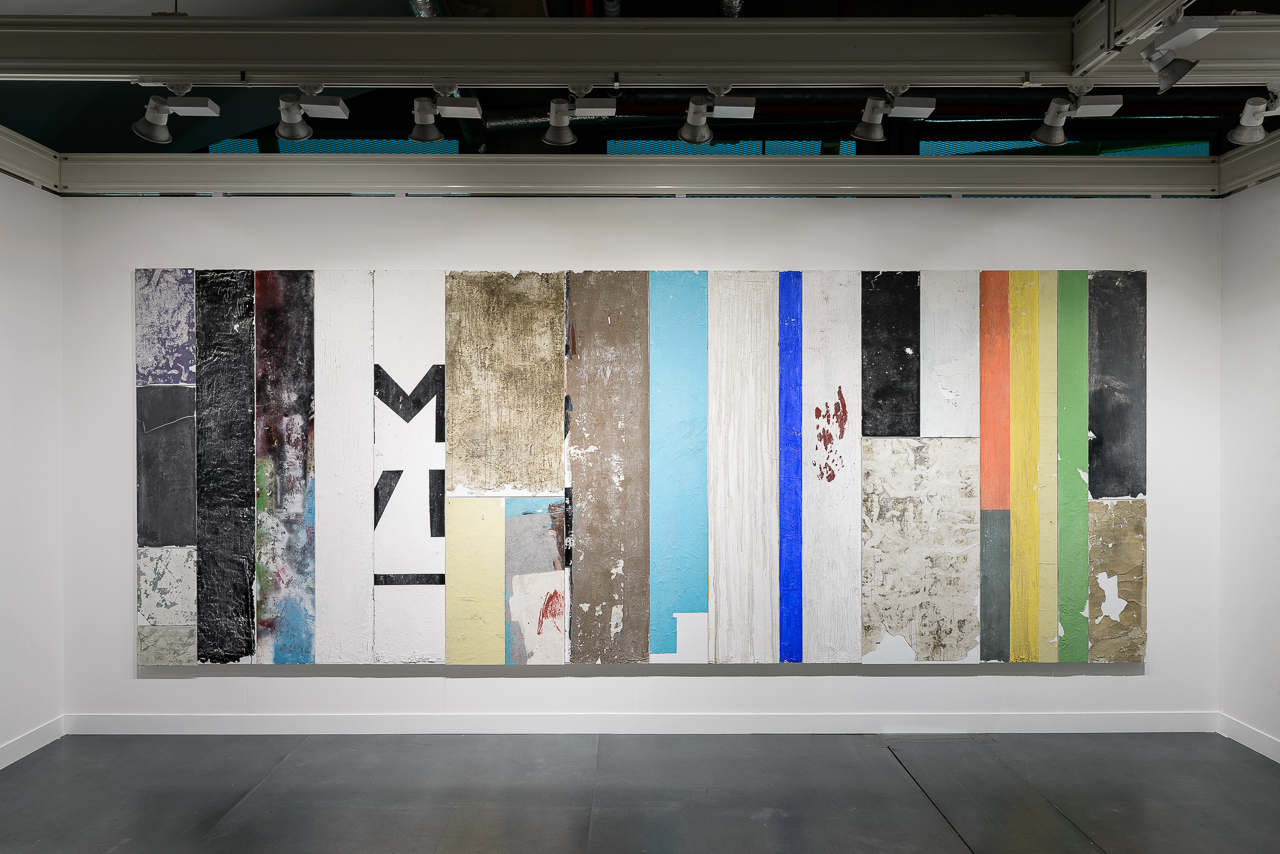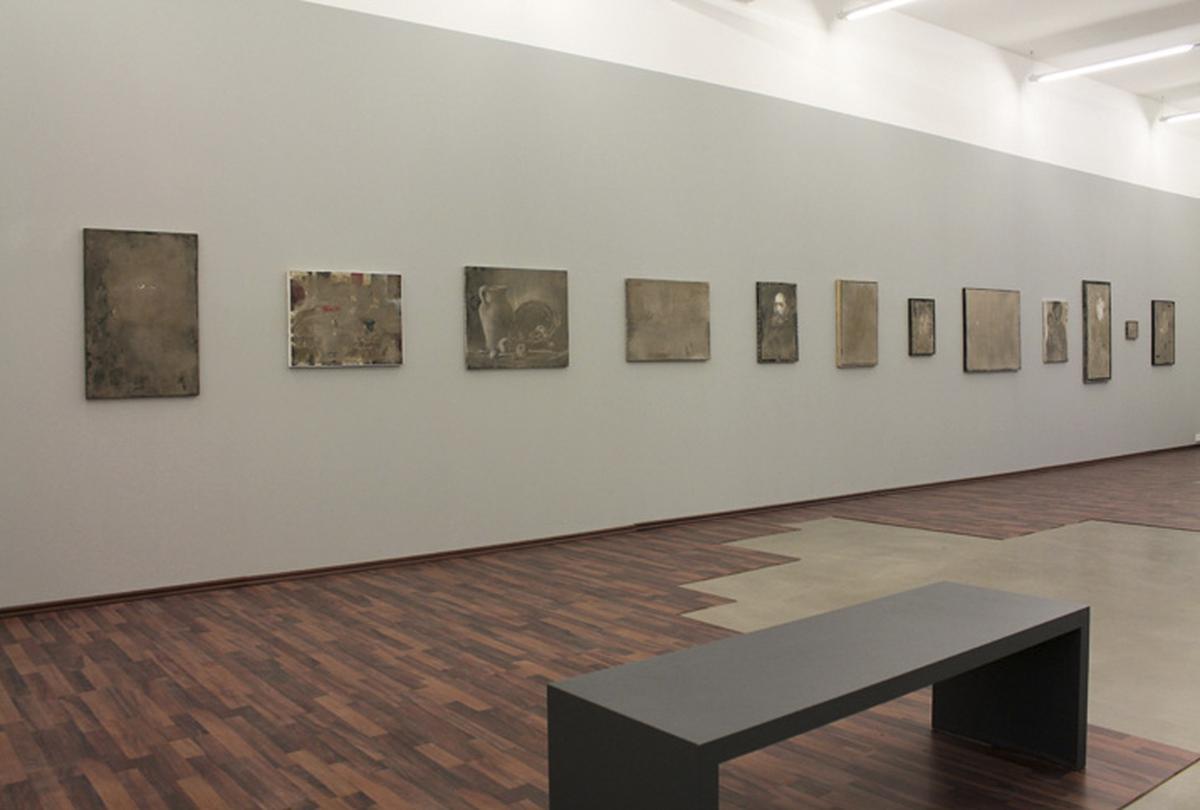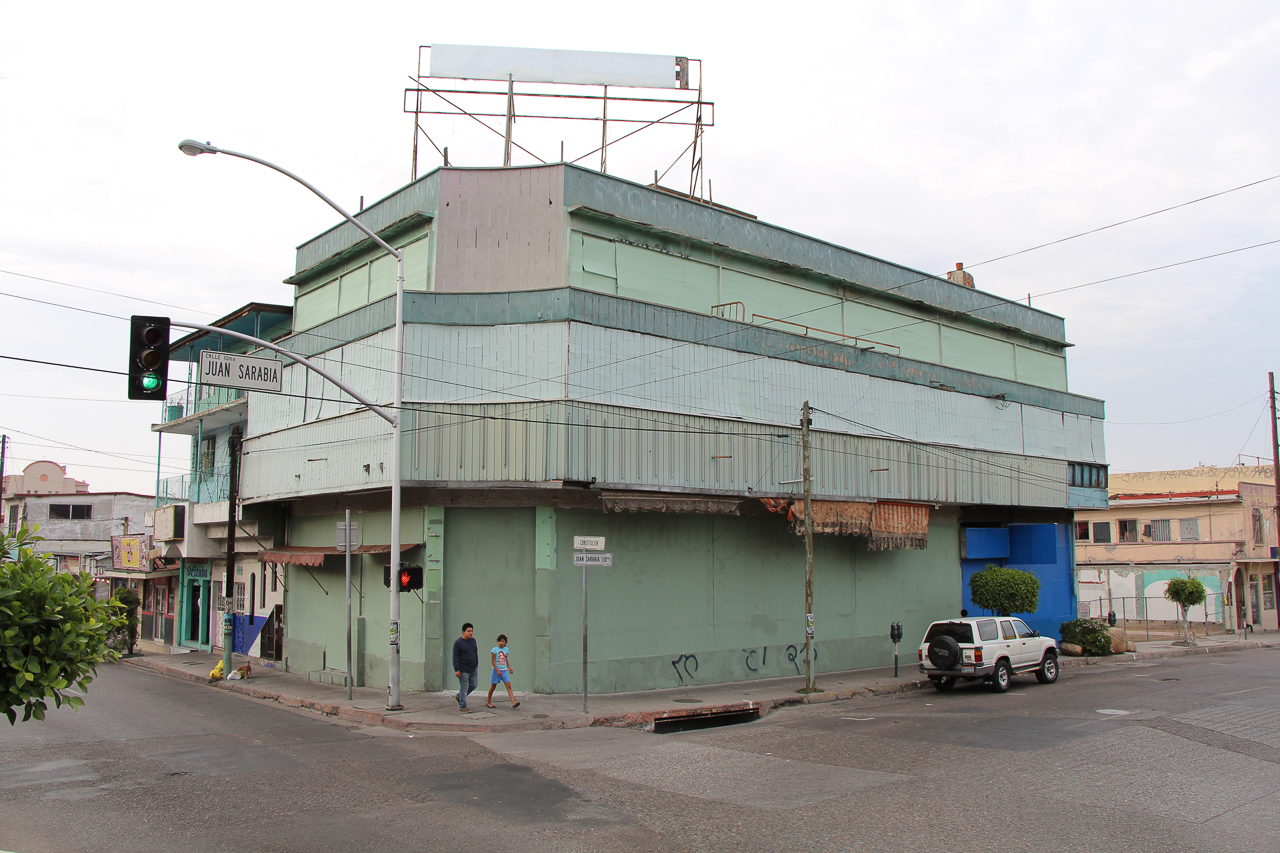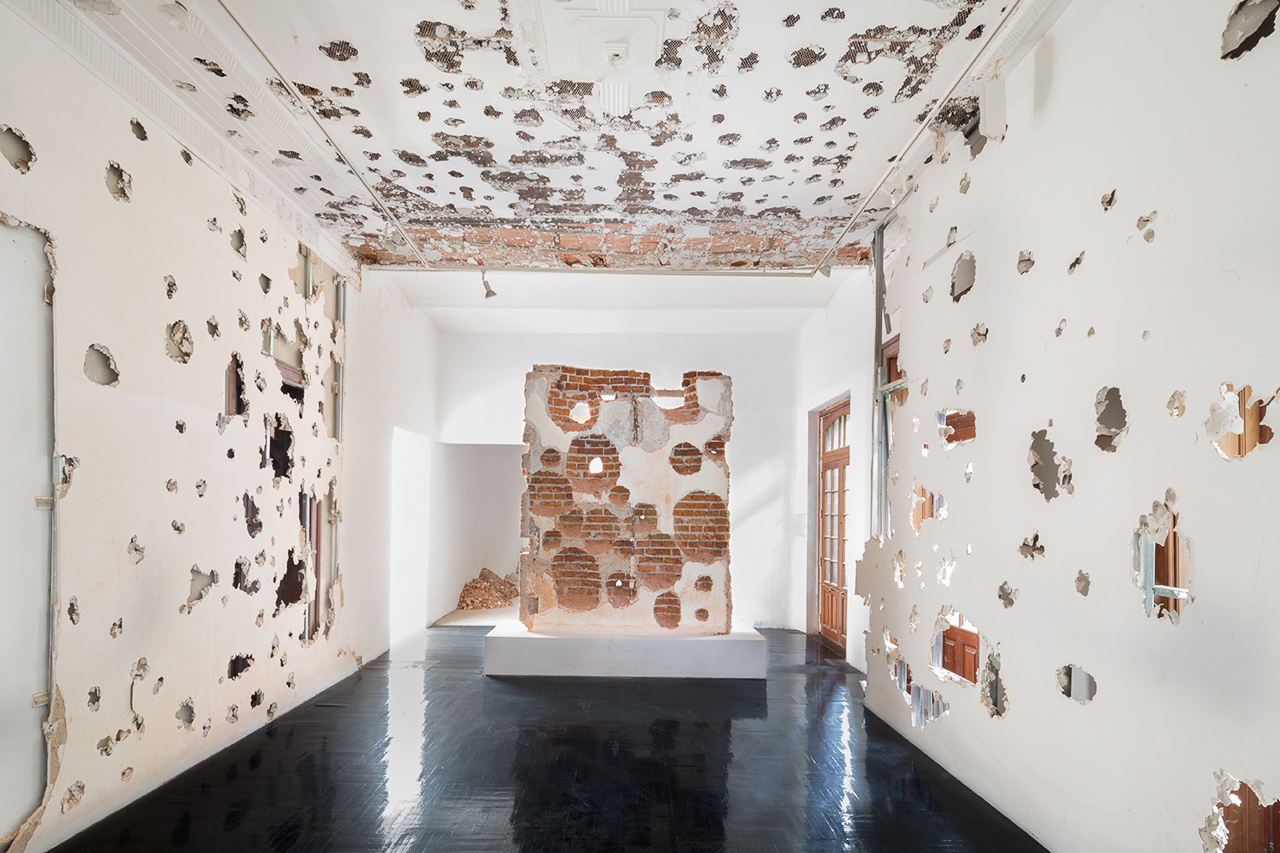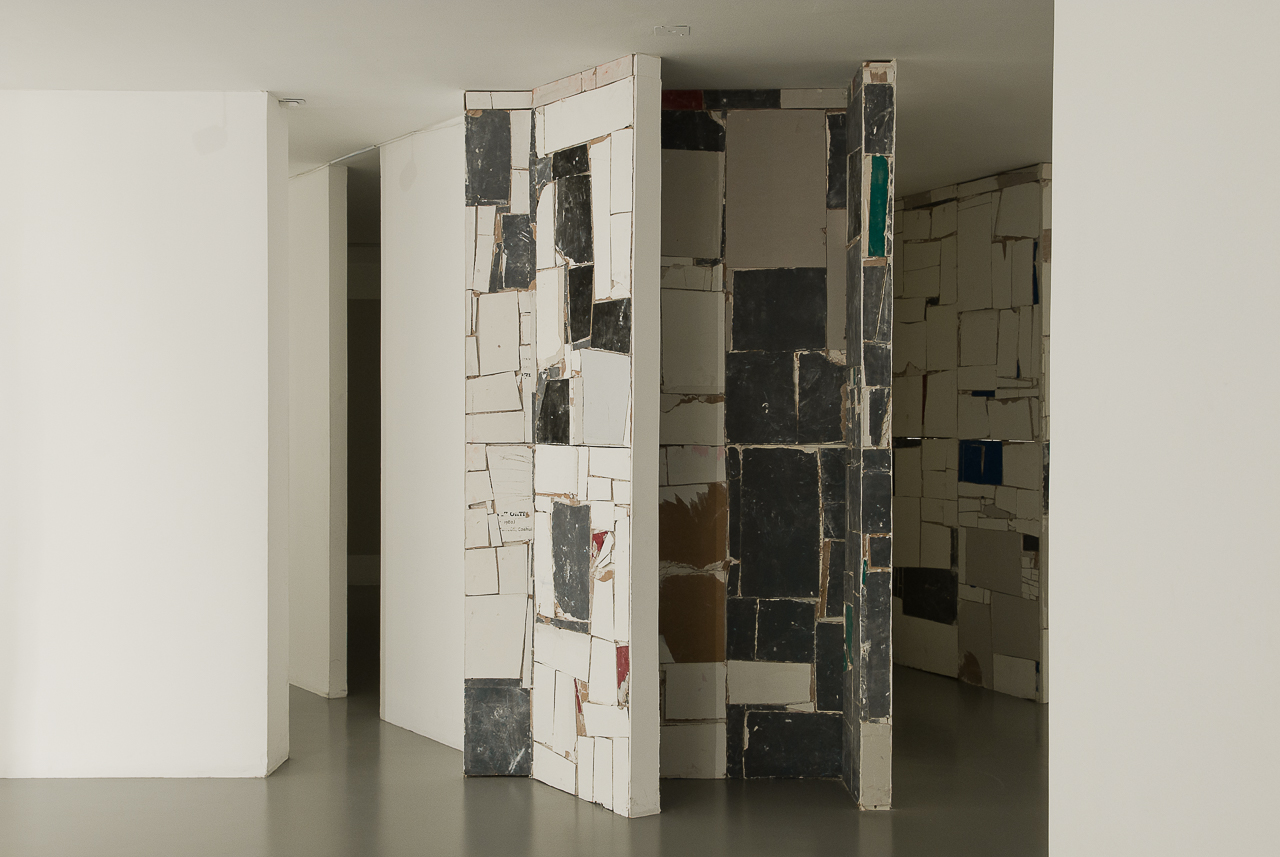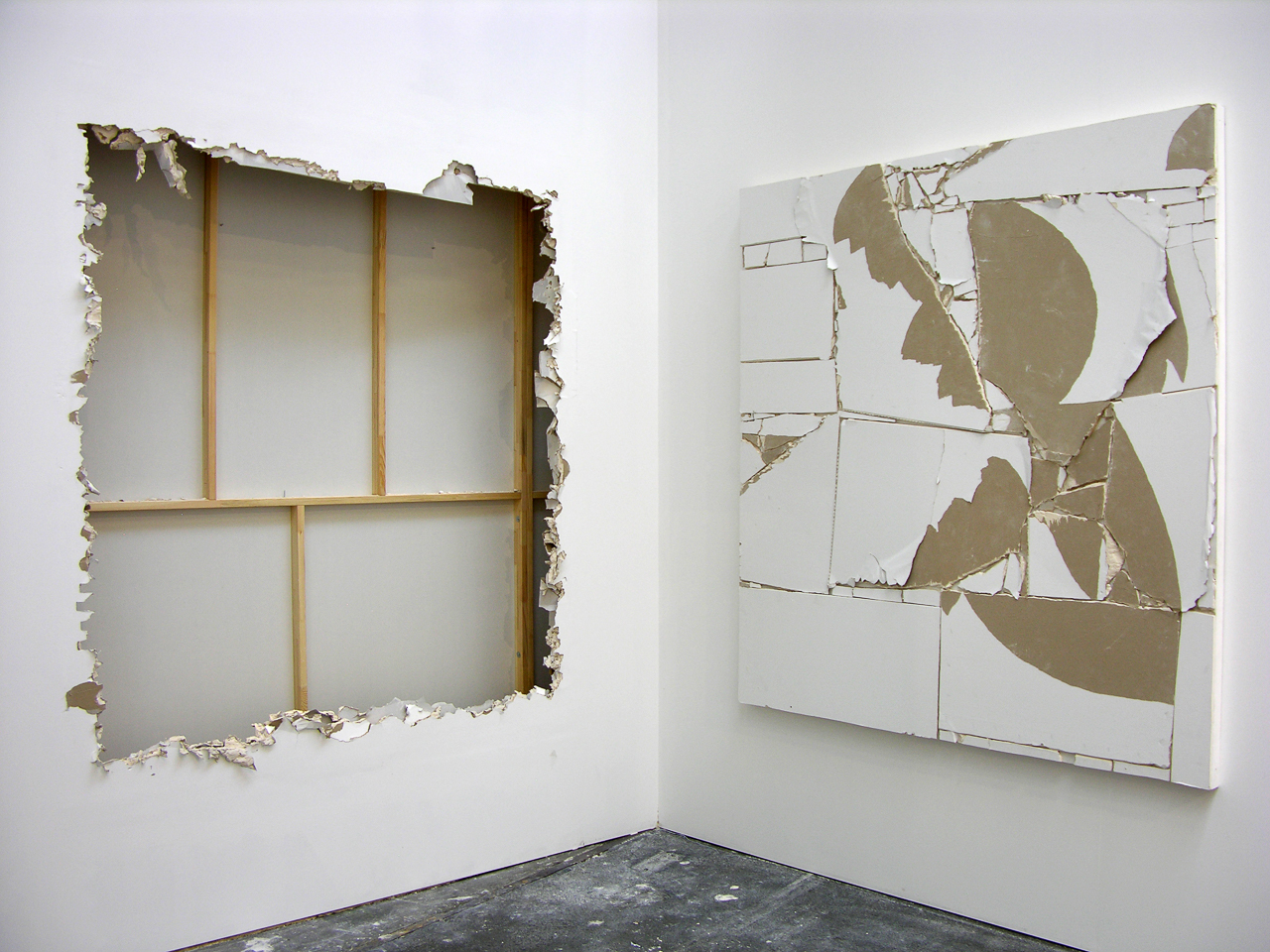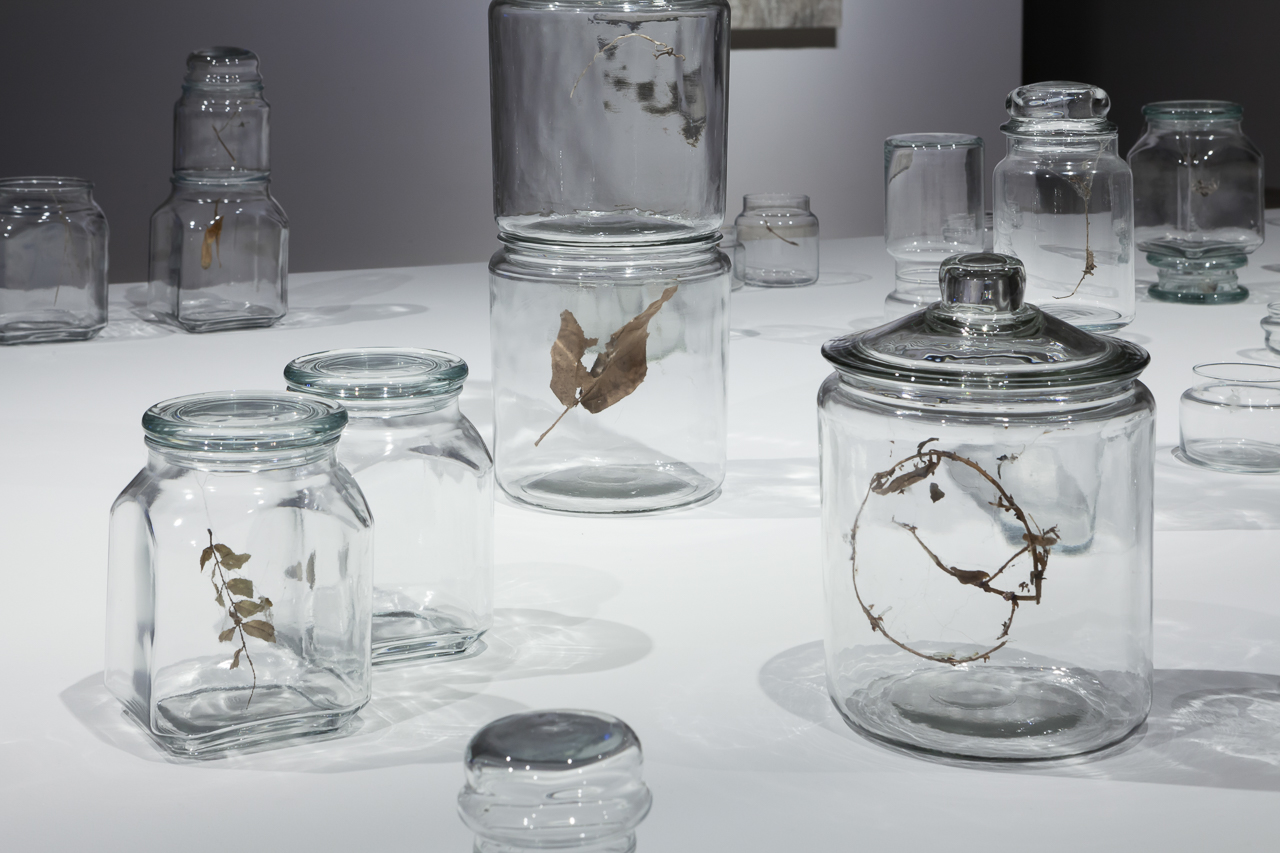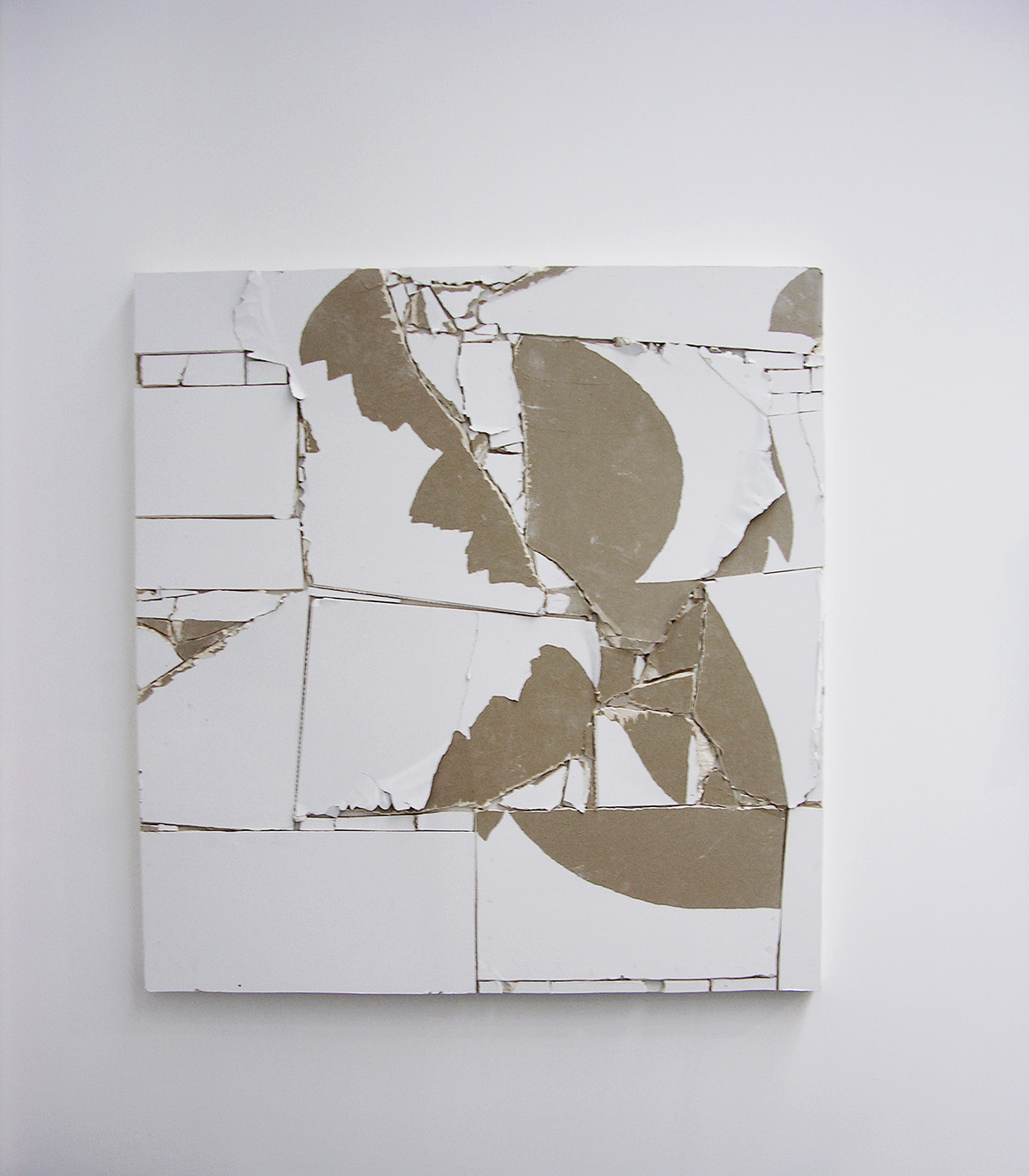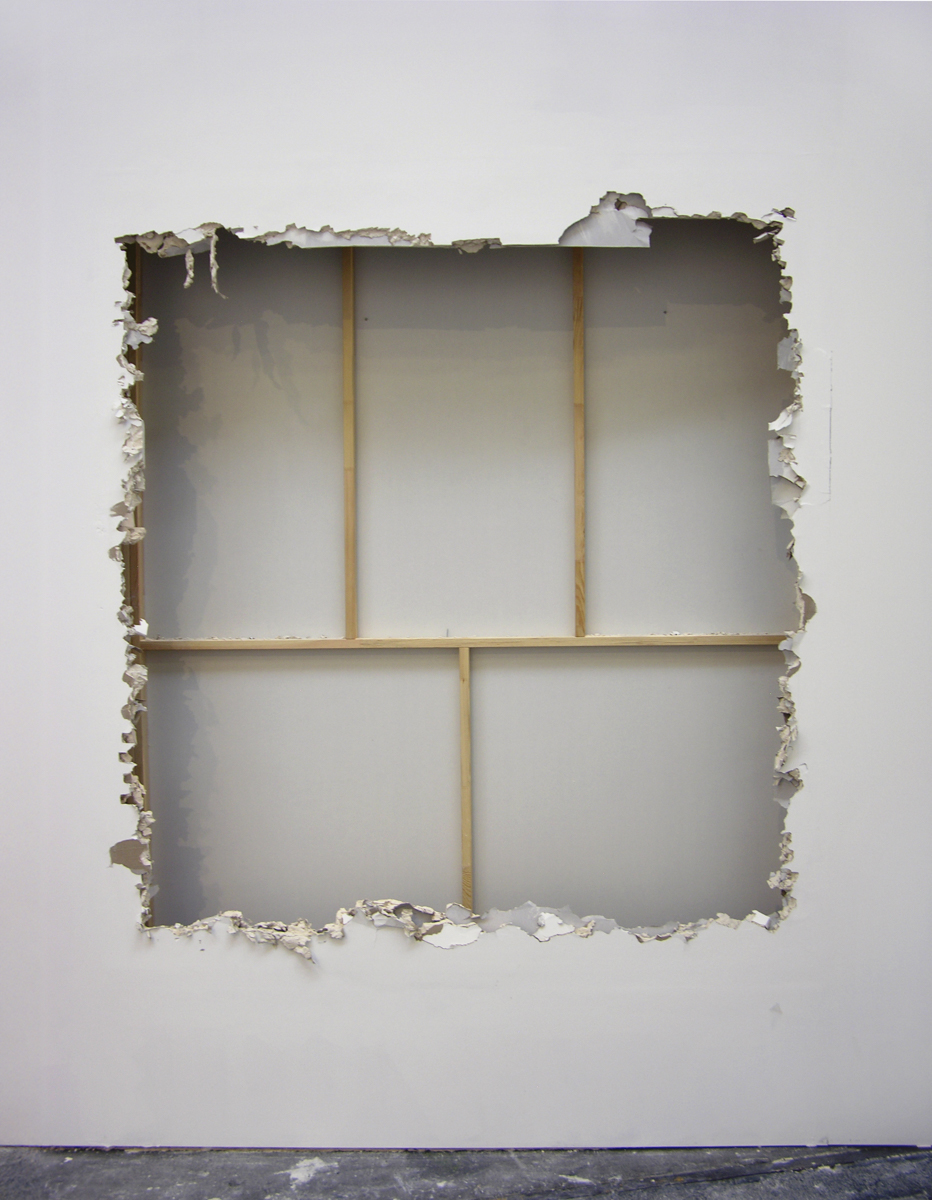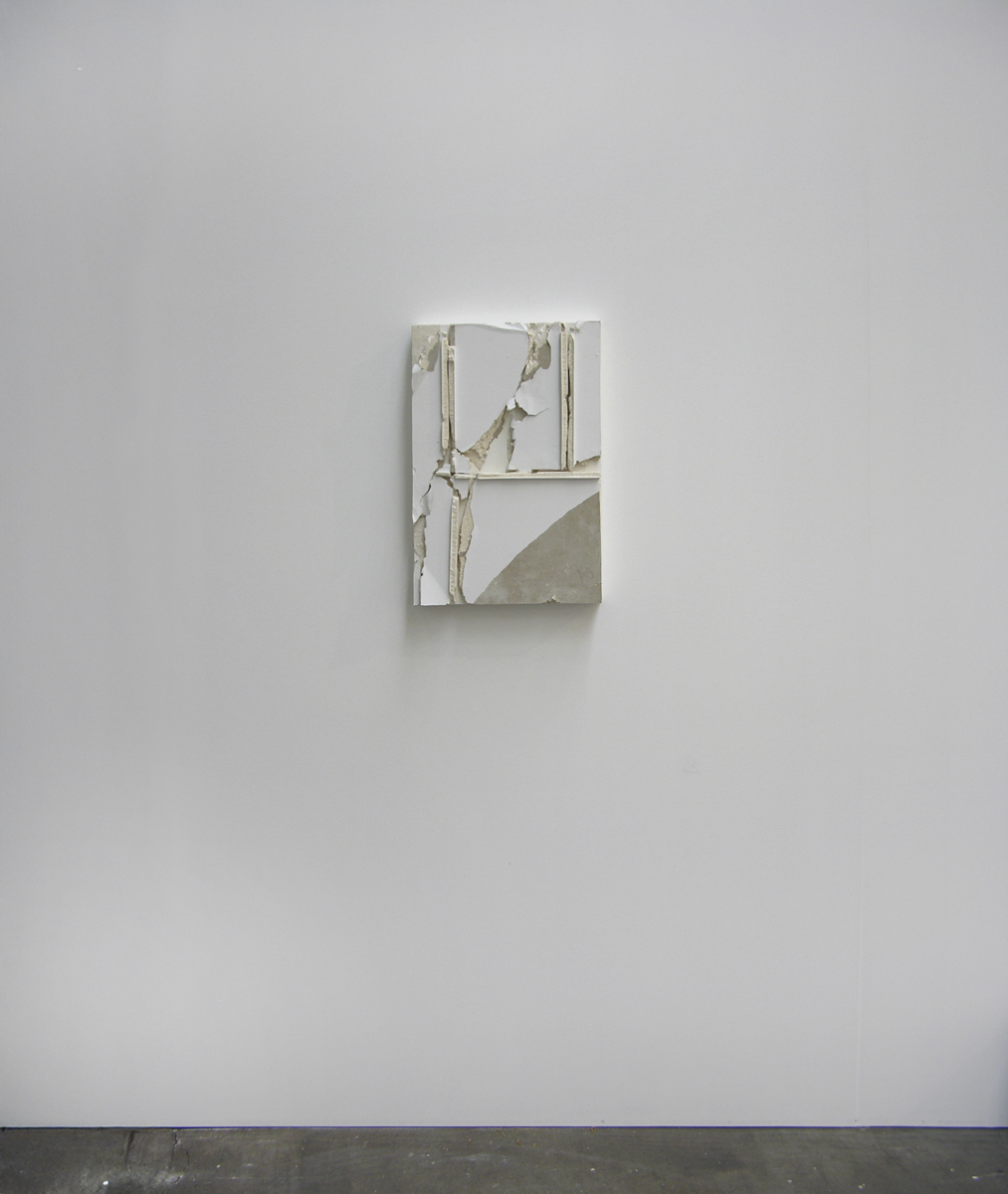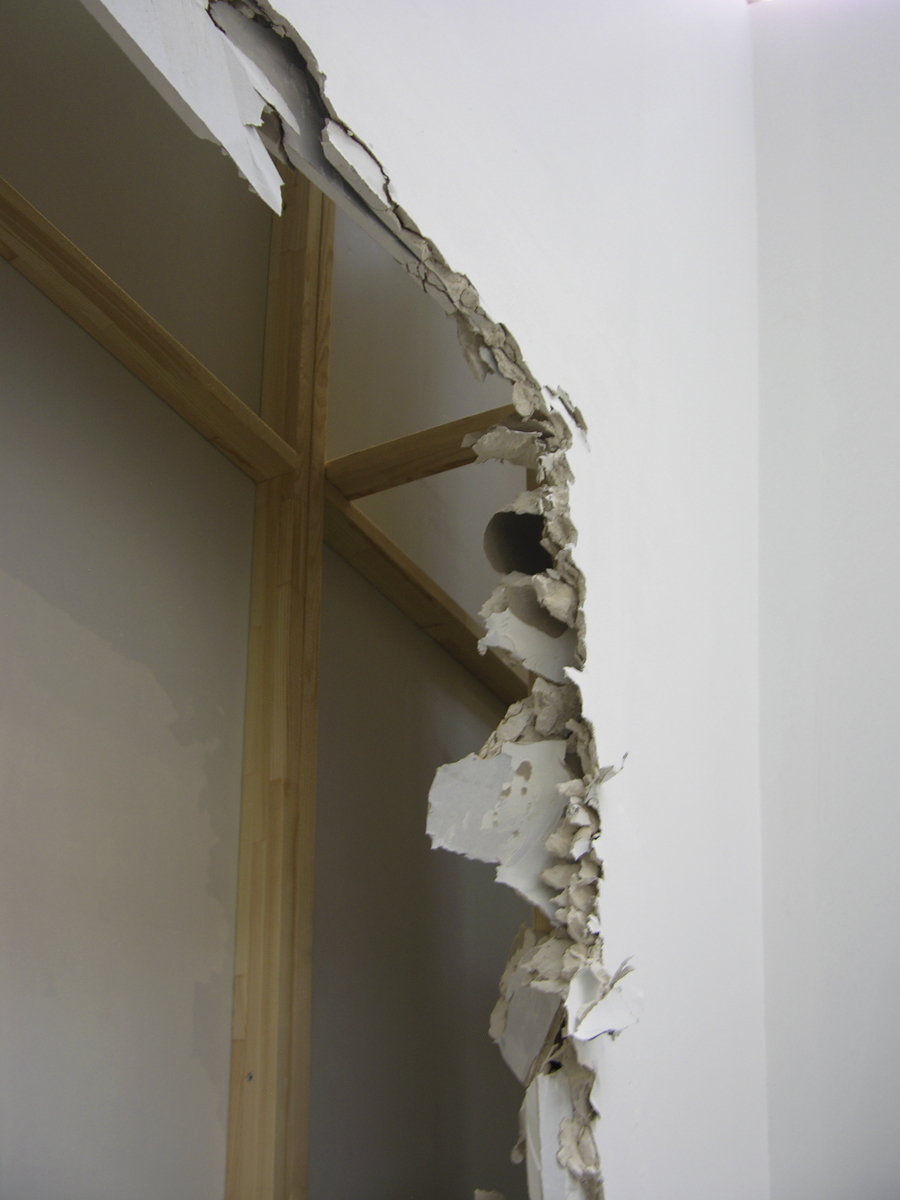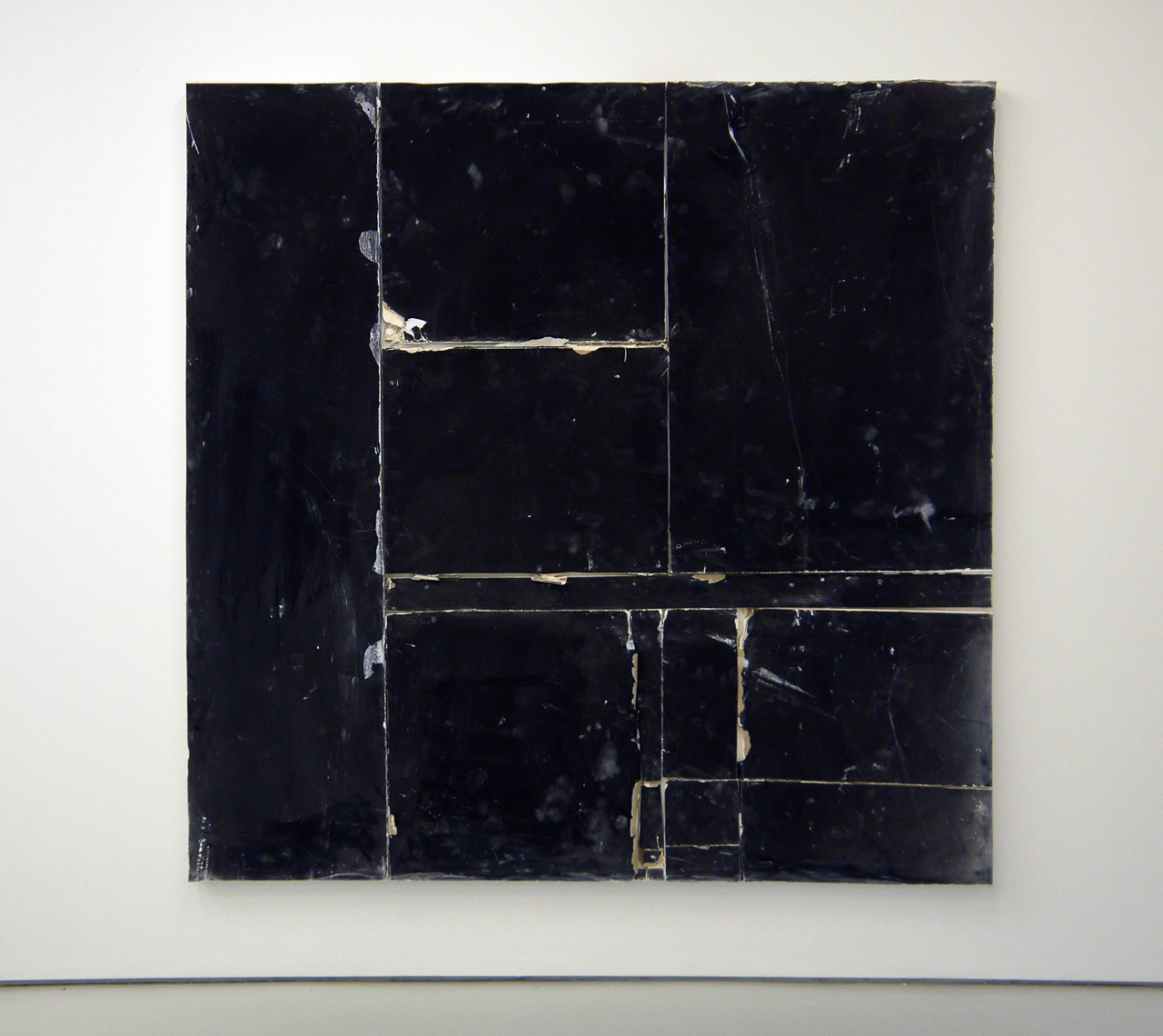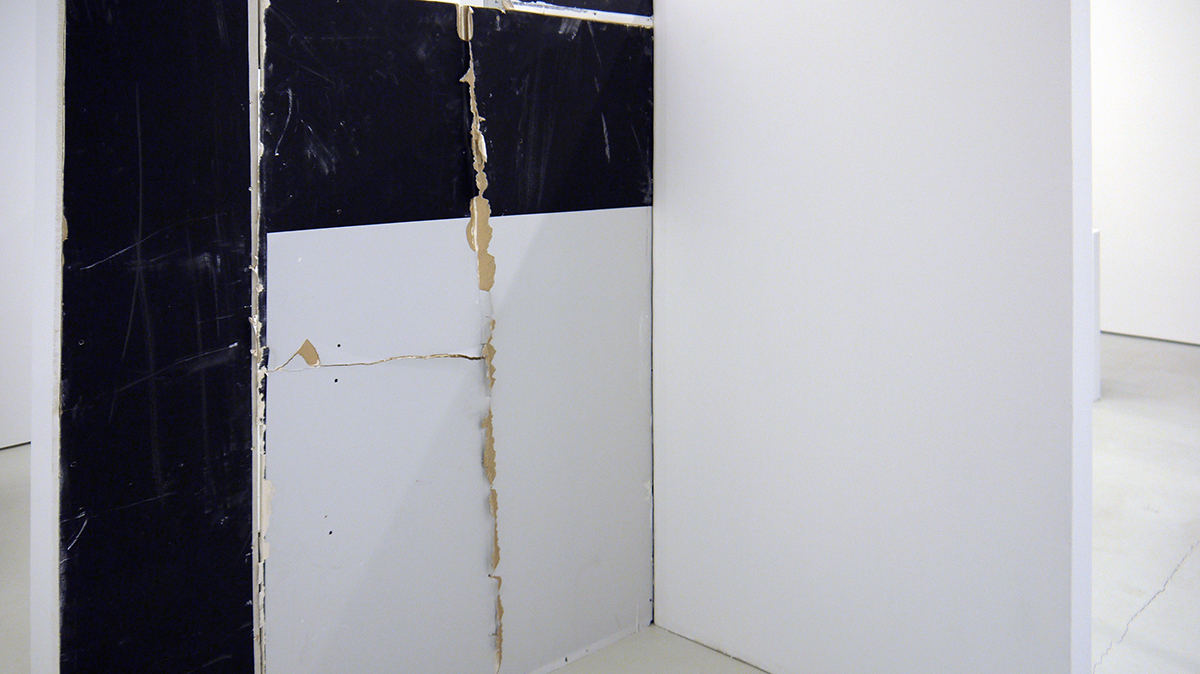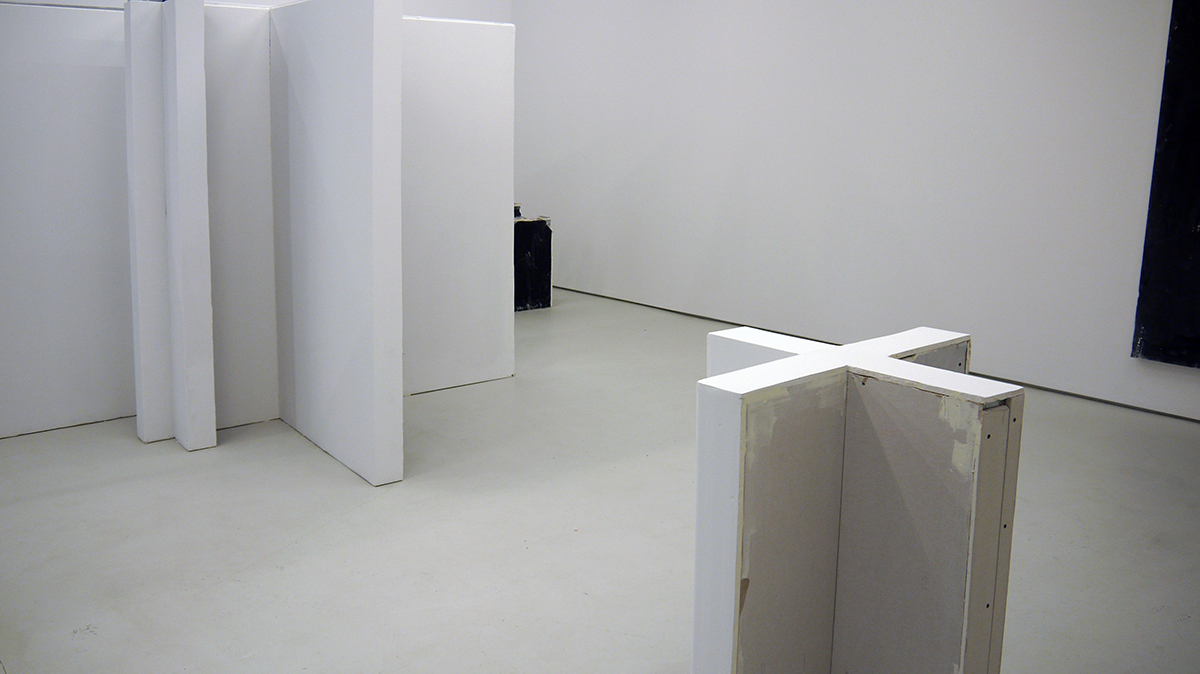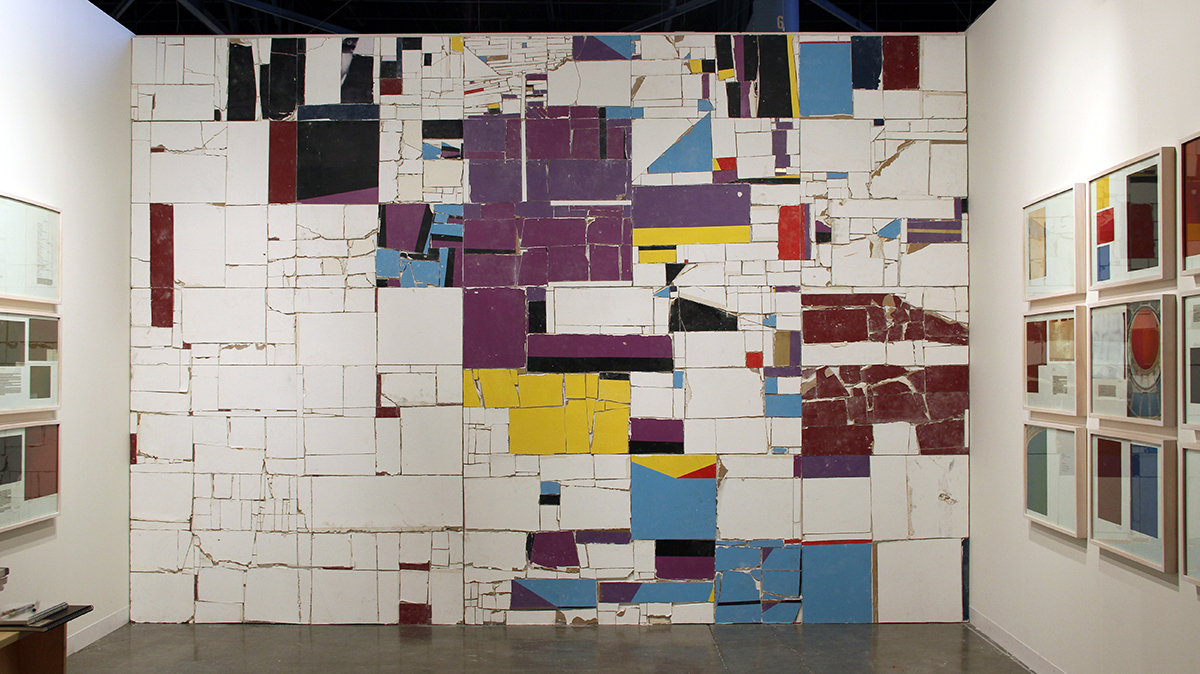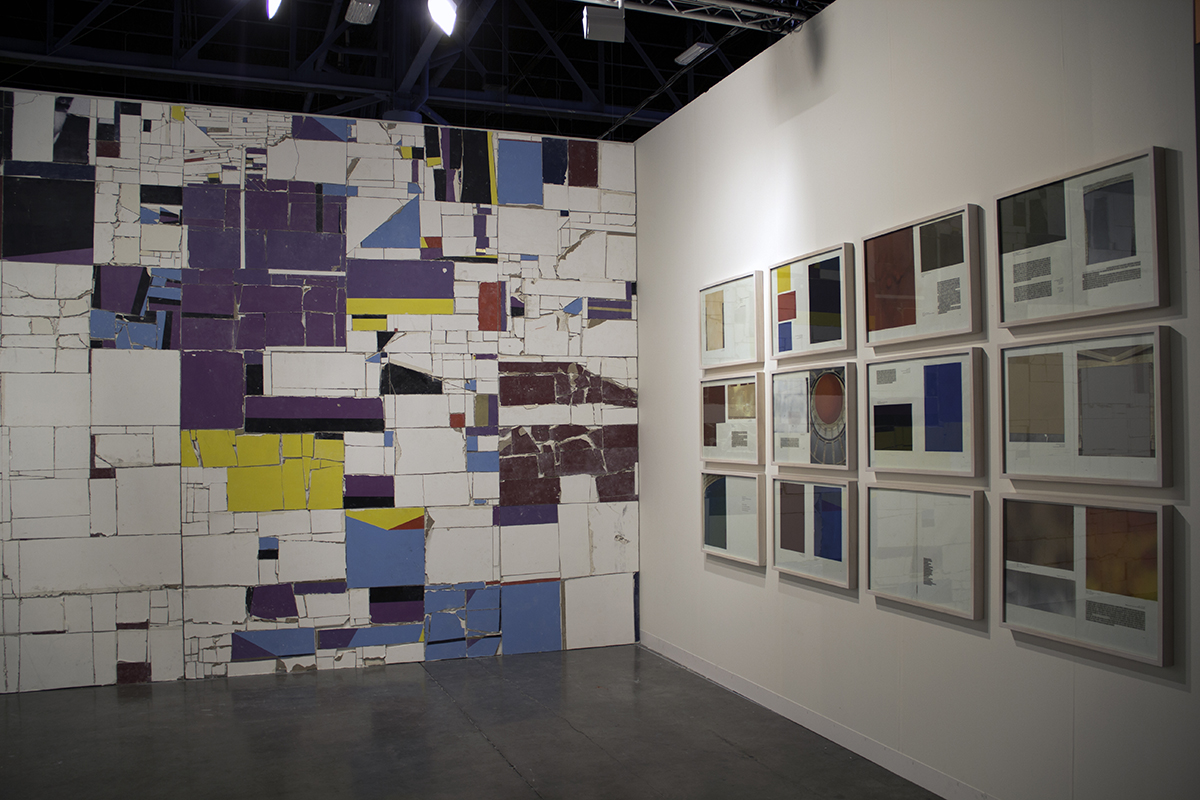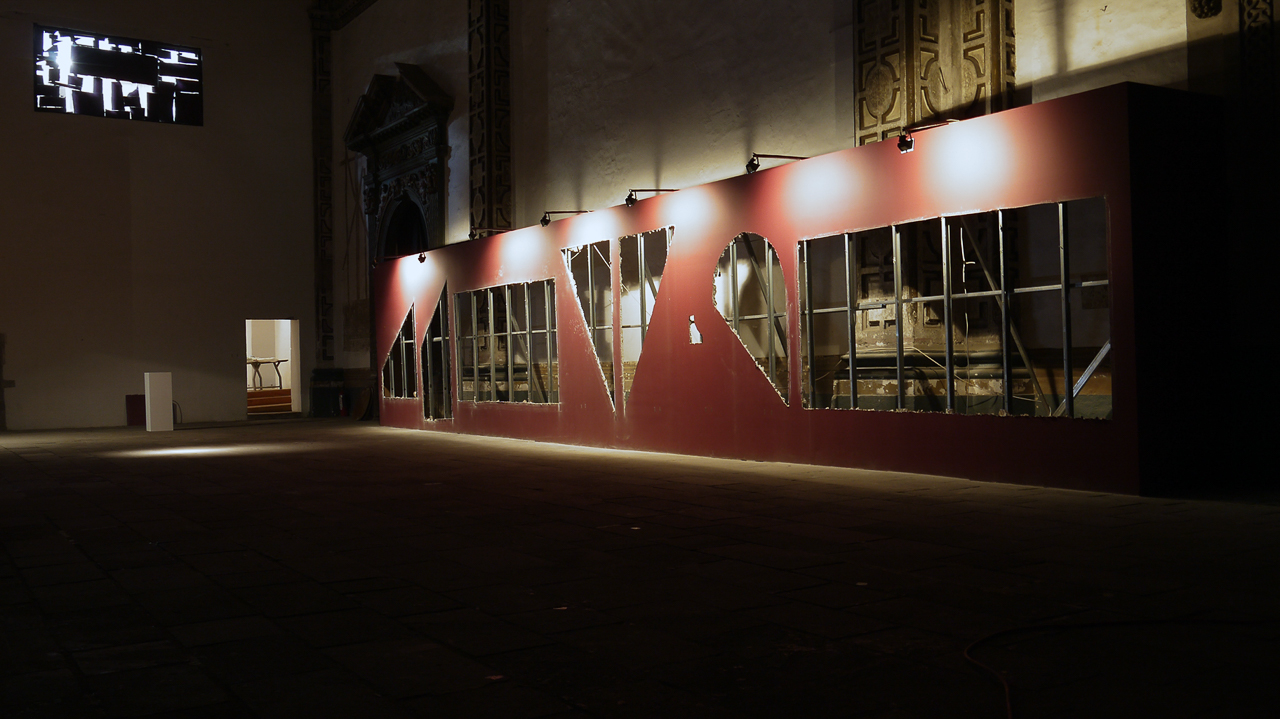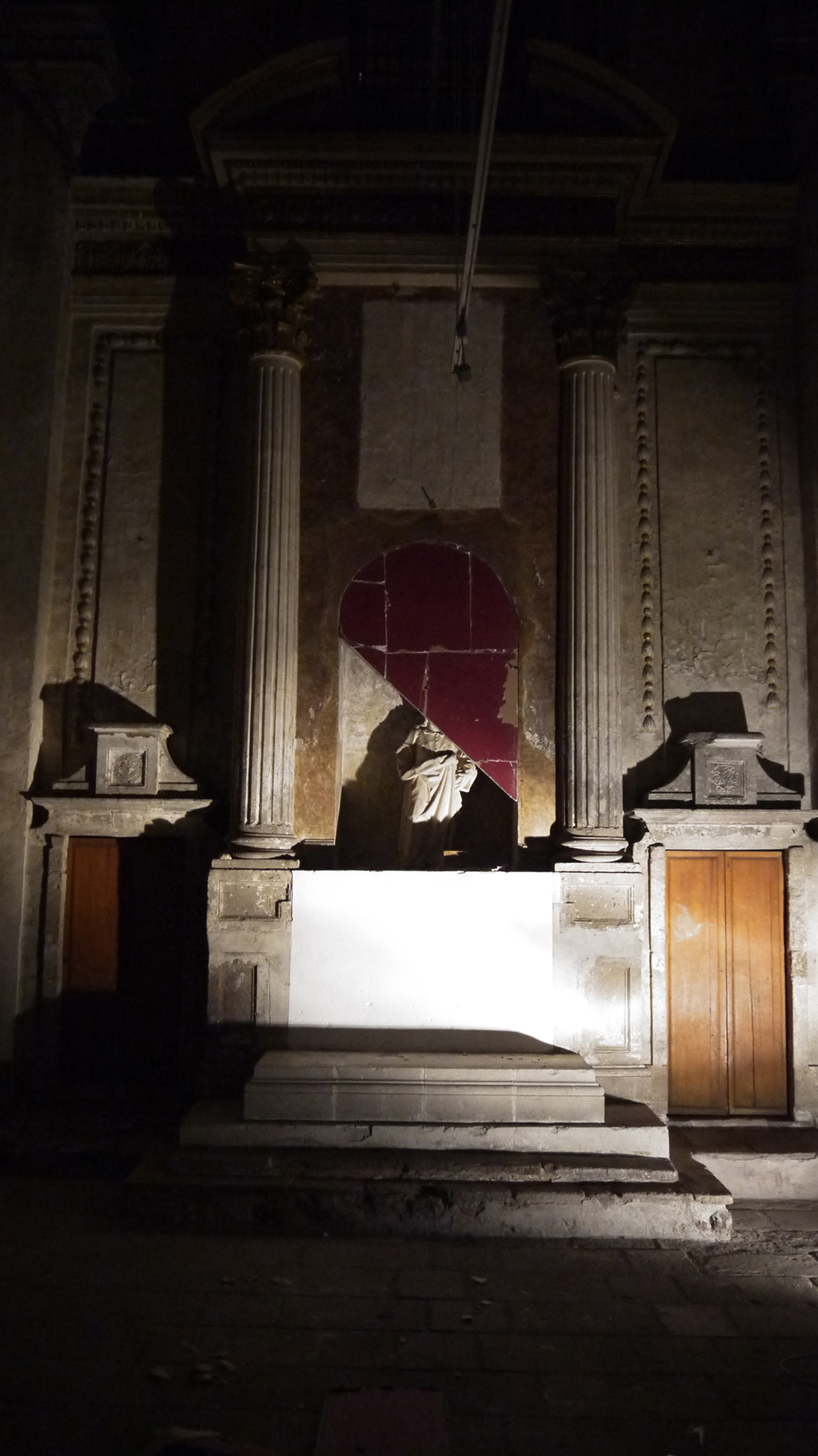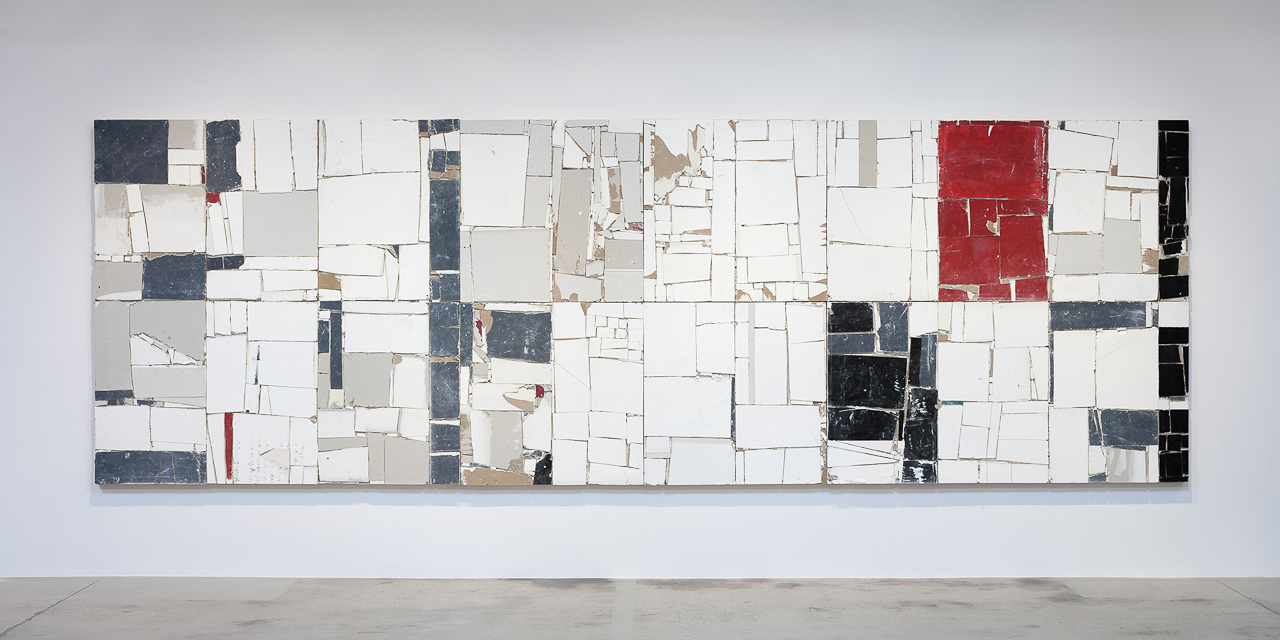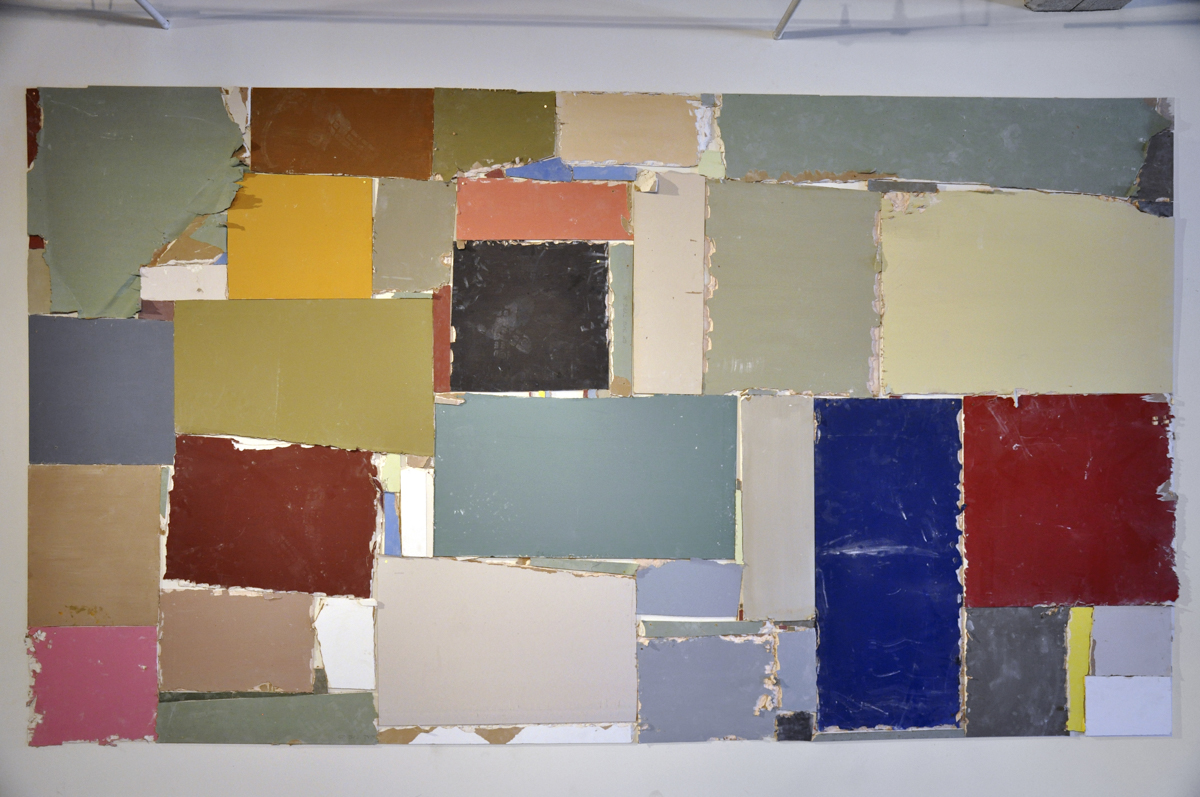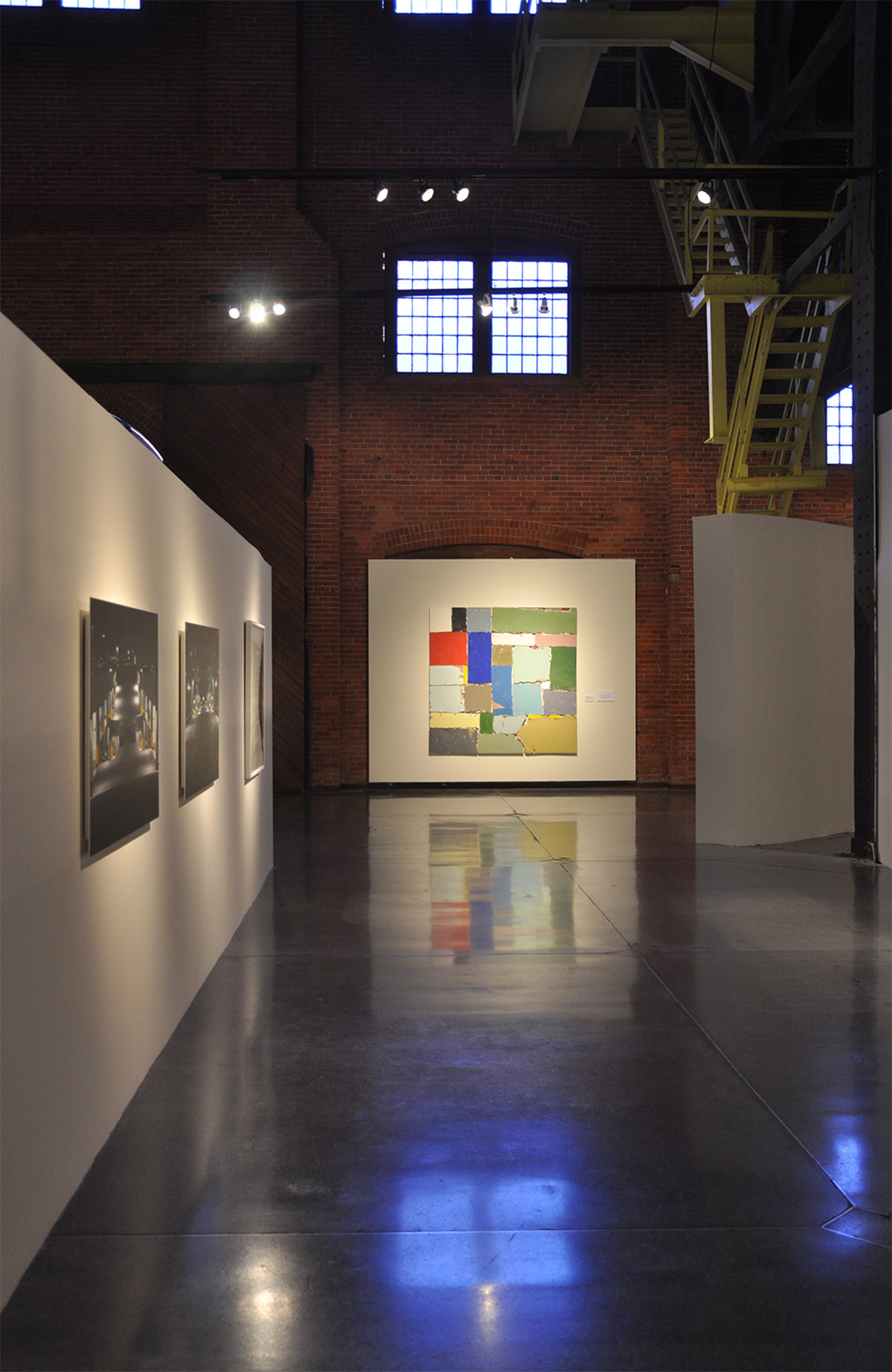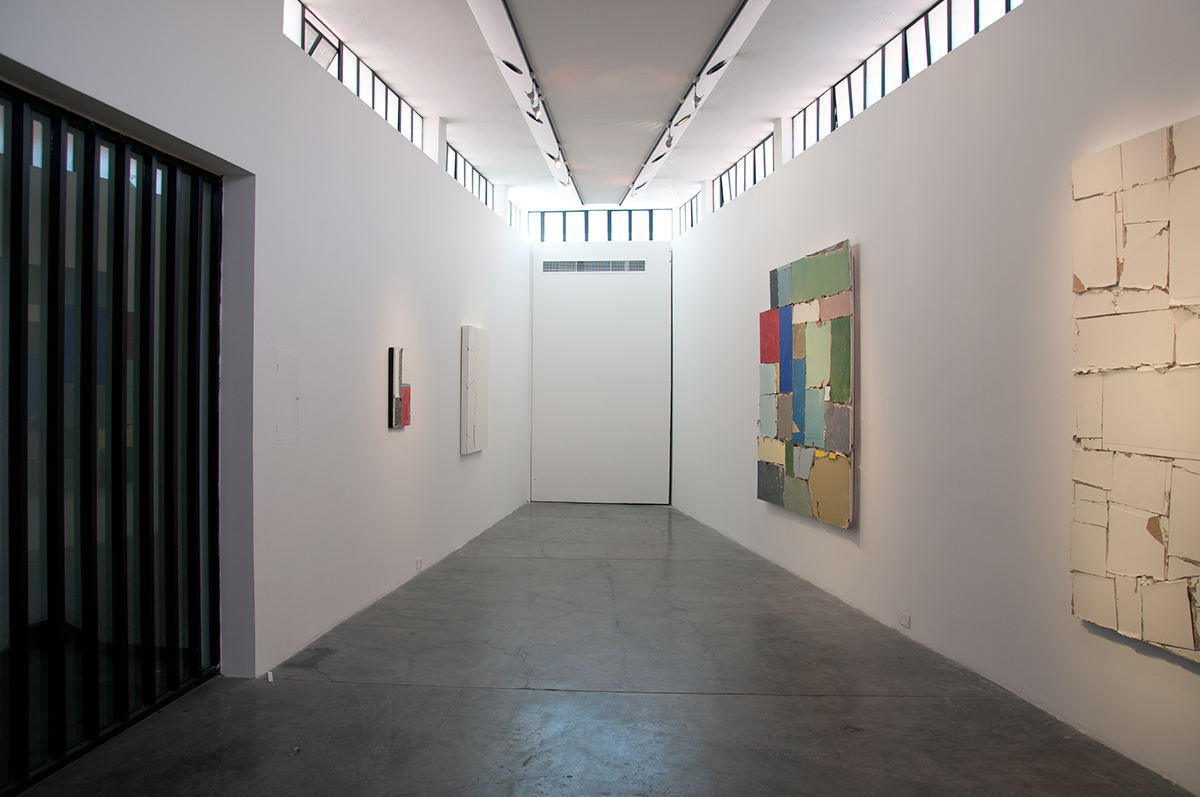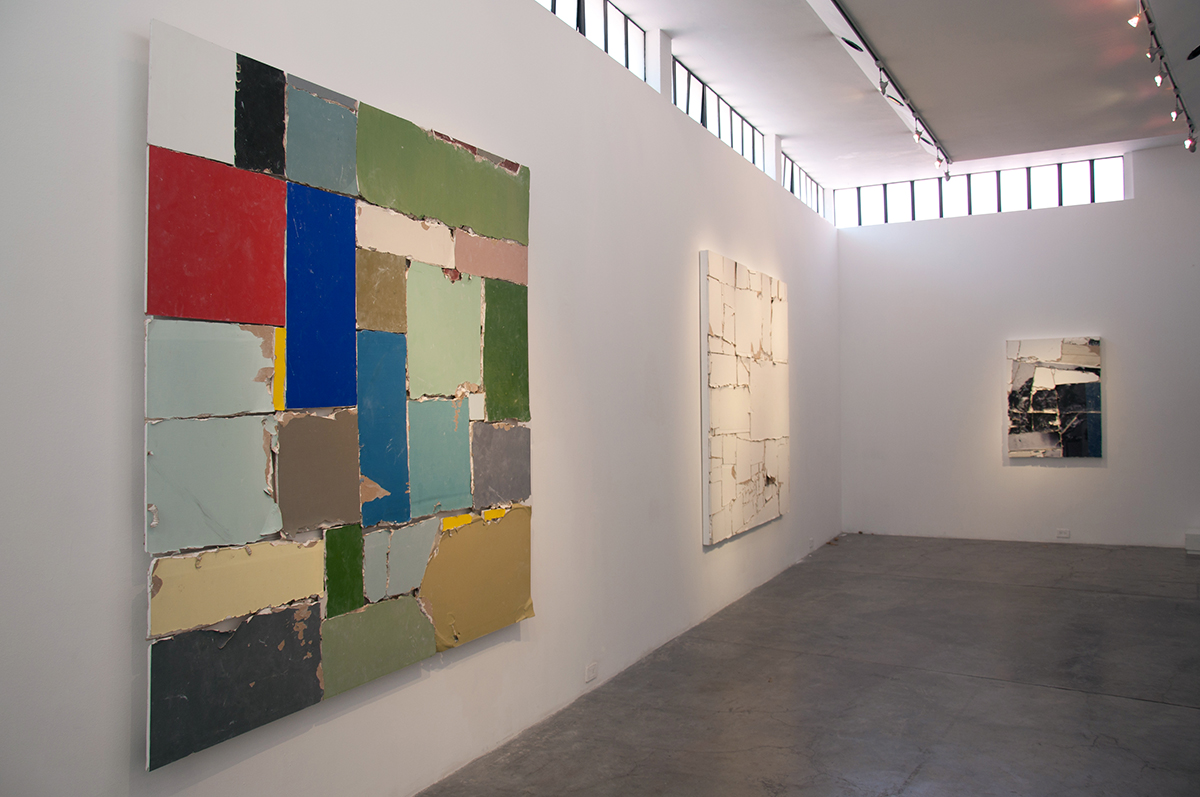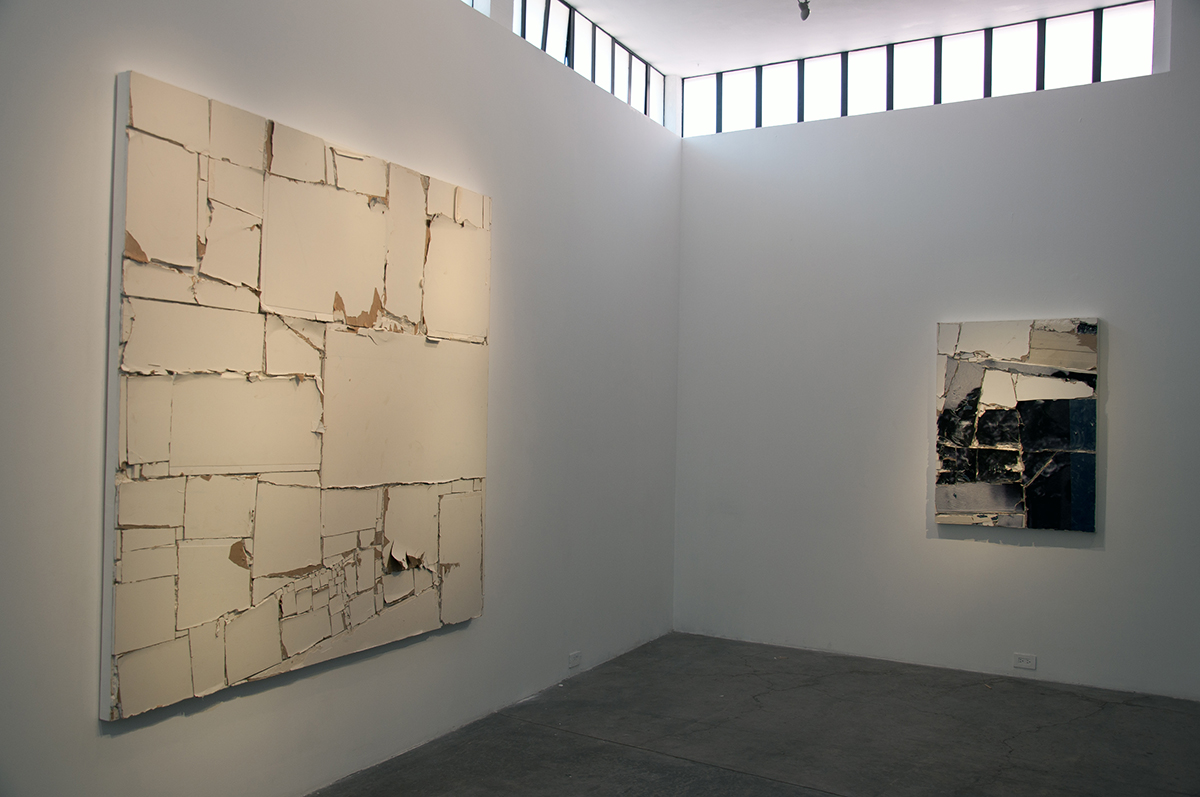Unfolded Architecture
Each work is made from drywall recuperated from several museums, pieces of this material left over from specific exhibitions. These fragments have been reconfigured into flat rectangular formats, which in scale and composition reference abstract paintings. Having previously been used to create three-dimensional spaces, the two-dimensional structuring of this drywall performs an ¨unfolding¨ of the previous temporary architecture; a large-scale, origami in reverse.
Each of this paintings evidence their previous contexts, displaying a variety of decisions taken in the design the exhibitions of which they were the physical support; such as the various colors of the walls, vinyl or photographic murals used, or the fonts engaged in the wall labels. These elements are often involved in curatorial and exhibition design strategies that consciously or unconsciously present museum spaces as atemporal, conveying permanence or the feeling of a space outside of everyday time. The pieces by Rasgado deconstruct this temporal structure, revealing museum spaces as ephemeral, in constant change, with each exhibition having its own lifespan. (excerpts from Tobias Ostrander’s “Arquitectura desdoblada”)
Materials
Recovered Drywall from specific exhibitions.
date
2007-2017
Exhibitions
⎖Bemis Center for contemporary Art, Nebraska
⎖Museo experimental el eco, CDMX
⎖ABC Berlin, Berlin
⎖Arratia Beer Gallery, Berlin
⎖MUCA Roma, CDMX
⎖Museo de arte moderno, CDMX
⎖Museo Ex-teresa Arte Actual, CDMX
⎖Steve turner, Los Angeles
⎖Museo Carrillo Gil, CDMX
⎖Expo Chicago, Chicago
⎖Art basel Miami, Miami
⎖CAM raleigh, NC
⎖North Carolina Museum of art, NC
⎖Almine Rech Gallery
⎖MUKHA, Brussels
⎖Art Brussels, Brussels
⎖Molaa, Long Beach
⎖Magazzino di Campo San Cassiano
Collaborators
⎖Tobias Ostrander, curator
⎖Rita Kersting, curator
⎖Osvaldo Sanchez, curator
⎖Carlos Palacios, curator
⎖Xavier Hufkens, curator
⎖GabrielA Urtiaga, curator
⎖Salvador Cañas, curator
⎖Marisa Vescovo, curator
⎖Bruno Barsanti, curator
⎖Alessandro Carrer, curator
Texts
⎖Tobias Ostrander
⎖Carlos E. Palacios
⎖Gabriel Villalobos
publications
⎖Unfolded architecture/arquitectura desdoblada ed. by Beau désordre press.
⎖Monochrome Undone
Ed. by RM and Sayago & Pardon.
⎖Pintura México Vol.1
Ed. by Sicomoro Ediciones.
⎖Art and Space ed. by BOB Magazine
⎖Arquine Agosto 2013
⎖192 Magazine
⎖Carga Util 39 artistas Contemporáneos en el MAM Ed. by the Museo de Arte Moderno
Texts
Tobias Ostrander
Published in:
⎖Exhibition text Museo Experimental el Eco
⎖Unfolded Architecture/Arquitectura desdoblada, Beau Desordre Press
The current presentation of the work of Pablo Rasgado, titled Arquitectura desdoblada (unfolded architecture), includes five works from a series of the same name. Each work is made from drywall recuperated from several museums, pieces of this material left over from specific exhibitions. These fragments have been reconfigured into flat rectangular formats, which in scale and composition reference abstract paintings. Having previously been used to create three-dimensional spaces, the two-dimensional structuring of this drywall performs an ¨unfolding¨ of the previous temporary architecture; a large-scale, origami in reverse.
Trained as a painter, this series forms part of a larger project by the artist, involving ¨found paintings,¨ which include a series in which Rasgado uses a fresco-related technique to create transfers of grafitti or dirt configurations found on urban walls. The resulting artworks, like those of his Arquitectura desdoblada series, formally reference a history of gestural abstraction. Both bodies of work however, critically distance themselves from the subjectivity associated with this artistic tradition, the idea that expressionist brushstrokes convey the emotions or psychic energy of the painter. The post-conceptual approach of Rasgado celebrates the accidents, coincidence, and chance involved in the use of found, everyday materials. His configurations are not devoid of aesthetic choices, but rather celebrate the limits imposed on these decisions through the use of pre-existing forms. Re-contextualization additionally plays a strong role in this artistic practice, with new meanings created as these materials move from one physical and temporal site to another.
The five drywall paintings presented at El Eco each evidence their previous contexts, displaying a variety of decisions taken in the design the exhibitions of which they were the physical support; such as the various colors of the walls, vinyl or photographic murals used, or the fonts engaged in the wall labels. These elements are often involved in curatorial and exhibition design strategies that consciously or unconsciously present museum spaces as atemporal, conveying permanence or the feeling of a space outside of everyday time. The pieces by Rasgado deconstruct this temporal structure, revealing museum spaces as ephemeral, in constant change, with each exhibition having its own lifespan.
These ideas take on a poetic charge in two of the works that use walls taken from the Museum of Modern Art in Mexico City, from exhibitions of the artists Helen Escobedo (this great friend of Mathias Goeritz) and Mario Rangel Faz, each of whom died during or shortly after these presentations. The fragility of these broken and temporary museum walls becomes equated with that of the human body and its mortality. This impermanence however, is delayed through these Arquitectura desdobladas, as Rasgado recycles these symbolic materials and give them a new form, prolonging their duration through their new status as works of art.
There is also a tautological and humoristic play articulated in this series. When viewed within a museum context, they read like aged mirrors of these spaces, setting up a “before, after and potential future” dialogue with the walls on which they are hung. Their relationship to architecture is also both conceptual and funny, as the thought of a physical building actually being unfolded is a fantastical idea and represents conjecture that goes against the weight and seriousness with which architecture is often discussed or explored. Within the context of El Eco an interesting relationship is implied between these ideas and the Emotional Architecture of Mathias Goeritz, described in his manifesto published in 1954. The German artist called for a critique of Functionalist architecture, through structures that sought to convey emotions. Perhaps irreverent and playful compared to the gravity with which Goertiz approached these questions, the unfolded structures by Rasgado nevertheless offer a contemporary form of emotive architecture. His artworks additionally dialogue with the reduced forms and monumentality promoted by the founder of El Eco, while provocatively constructing new relationships with painting and formal abstraction.
Carlos E. Palacios
Published in:
⎖Tierra Adentro Magazine, num 170 Jun-Jul.2011. Print.
⎖Unfolded Architecture/Arquitectura desdoblada, Beau Desordre Press
“Only a miracle will prevent it from ending.” This fatal prediction from Douglas Crimp, the famous art critic, summarizes his iconoclastic attitude toward painting as printed in the pages of that ’70s and ’80s bastion of conceptualism, the also-famous October magazine. It’s no coincidence that the name of the article containing this phrase, published in 1981, was also as much of a death sentence as the blade of a guillotine set to fall: The End of Painting.
But this wasn’t the only episode in his personal war against this technique. A year before, Crimp published a classic essay on postmodernity in the same magazine, titled On the Museum’s Ruins. Based on a critique in The New York Times on the new galleries of 19th-century paintings at the Metropolitan Museum, the author reflects on the postmodern works of painter Robert Rauschenberg and on the ‘death’ of the museum: an essayistic tour taking in Flaubert as cited by Michel Foucault, Flaubert’s own Bouvard et Pécuchet and his readings on Manet, and even André Malraux’s Imaginary Museum. The trip is replete with quotations and literate references, arriving to the conclusion that the text announces in its epigraph, signed by Theodor Adorno: “museums are like the family sepulchers of works of art.”
Death, sepulchers, ruins. Categorical words that in the works of Arquitectura Desdoblada [‘Unfolded Architecture‘], painter Pablo Rasgado’s (Zapopan, Jalisco, 1984) latest series, acquire echoes of renewed intent and bet on the survival of painting from its currently ruinous state. Efforts that arise from the picturesque but are not by definition paintings. Visual gestures created from a work of restoration―never put better―but which do not attempt to recover anything useful in their appearance. Propositions in which the remains hidden among ephemeral works of architecture make themselves visible in museums, works from other artists from other eras.
And so, Pablo Rasgado’s strategy in Arquitectura Desdoblada of assembling the remains of false walls that at some time were raised in museums and art centers bears the twin-purpose of reinsertion and recuperation. On one hand, the artist fosters the traditions of modern painting―its death knell is worth remembering here―and on the other, he rescues the museum’s ruins (paraphrasing the title of Douglas Crimp’s famous article) using construction materials discarded by the ravenous machinery of expositional production, banking on the elegance of the visible to exercise a type of institutional critique.
With respect to the recovery of the picturesque, the artist revives the modernist traditions of assembly: the direct inheritance of the avant-garde hallmarks that are collage, and its counterpart, décollage. In this way, in his latest works the artist draws on a prior sequence of explorations that he has been working on for some years now as part of another series of works; he uses a restoration technique (strappo, with which murals are taken off their former surfaces) and relocates bits of unremarkable urban murals with zero creative intervention. In this type of décollage, Pablo Rasgado does not intend―as is the case with new-realist pioneers such as Raymond Hains, Mimmo Rotella, and Jacques Villeglé―to deconstruct a cumulative and random collection of urban materials, but rather presents the fragile skin of foreign and anonymous paintings: an effective mechanism for reappropriating that relativizes painting techniques and deems a painter as less someone who makes ‘paintings’ and more someone who produces what a semiologist would call a ‘semantic calque’ around the ‘picturesque.’
Along with the rebirth that Pablo Rasgado intends with his avant-garde processes, in Arquitectura Desdoblada he takes aim at gestures that extend beyond the simple layers of paint and arrive to the elusive border between chapters in the history of art and, as mentioned above, the so-called institutional critiques. As these assemblies refer―on a formal level―to a certain deconstructive reading of abstraction (evident in the large piece of old partitions from the Bemis Center for Contemporary Arts), they also depict ruins as a protagonist in the history of painting.
And it’s here in particular that the works in Arquitectura Desdoblada display their greatest strengths. Pablo Rasgado does not treat the adjectives that are traditionally associated with ruins and have to do with ‘how picturesque’ a work is or how much it deserves to be painted: the romantic value of ruins in a landscape (the remains of an age-old temple in a forest is a good example) isn’t emphasized; rather, ruins become more a ‘real’ than a metaphorical resource. Their taxonomy within the classical form of two-dimensional painting and the abstract supposes the partial rewriting of the history of institutions from whence these architectural remains proceed. Each work is built with the remains, legible or not, of a work whose statement is inscribed in its respective title, evidencing a certain fragility to institutional memory as well as the speed of a museum as a producer of ruins from a materialistic perspective.
Finally, a good image from the 18th century crystallizing Pablo Rasgado’s ‘picturesque’ strategy can be found in the reflections of priest, educator, artist, and essayist of landscape paintings, William Gilpin: “A construction built following Palladio’s rules was harmonious, proportionate, and elegant, but in order for it to be of pictorial interest, one part had to be destroyed and the other torn down, leaving the mutilated remains abandoned. Then we would have transformed a tidy building into coarse ruins and no painter that could choose between the two would have any doubt about it.”
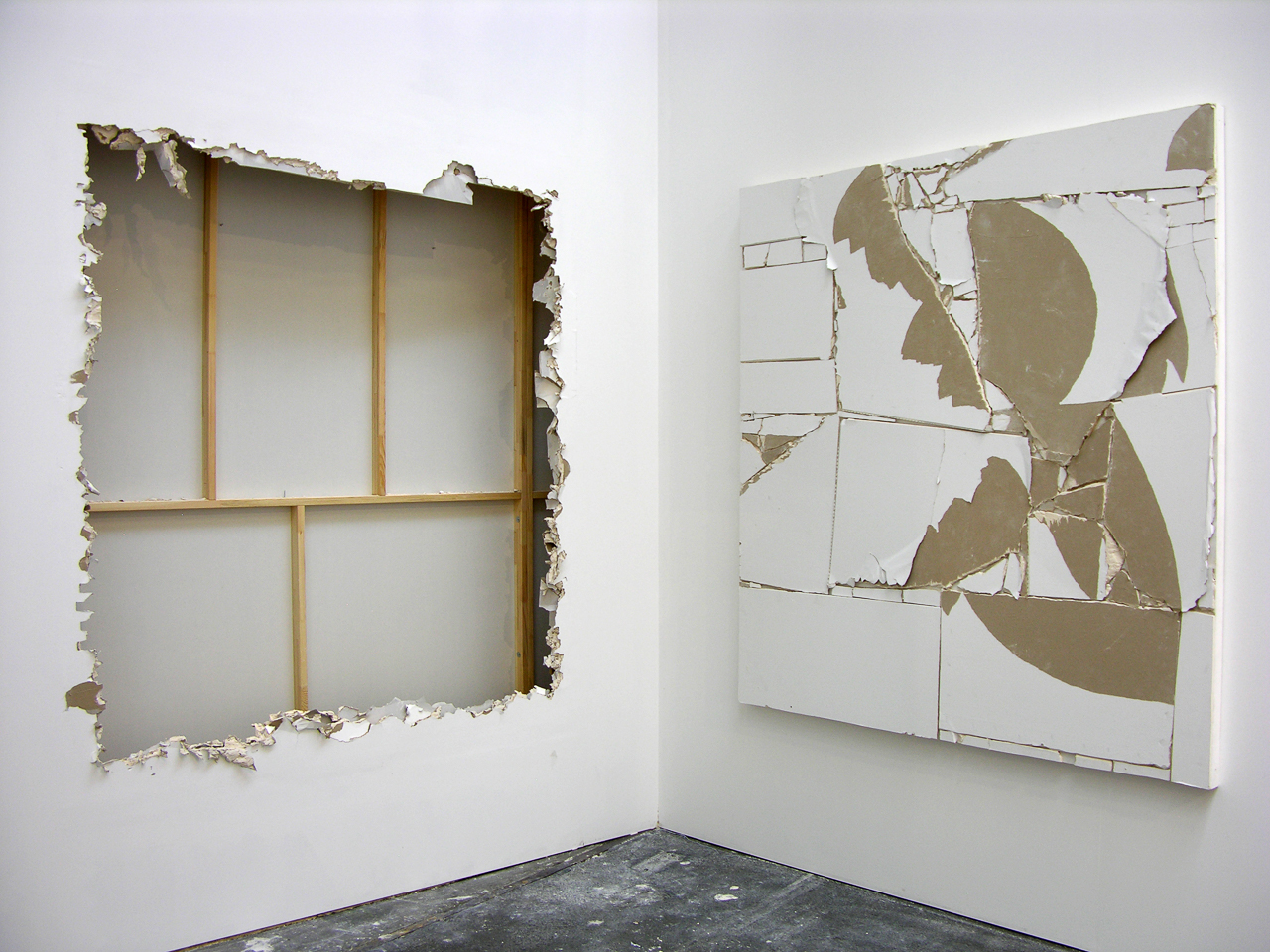
pablo rasgado, unfolded architecture, 2007-2017. Recovered Drywall from specific exhibitions. ABC BERLIN, 2011.
Unfolded Architecture
VENUEs:
Bienal Femsa, Centro de las Artes (Nuevo León)
Itinerancia: Centro Cultural Tijuana (Tijuana). Galería de Arte Moderno y Contemporáneo Ángeles Espinosa Yglesias (Puebla). Casa de la Cultura de Puebla (Puebla). San Pedro Museo de Arte (Puebla).
Juried by:
Juan Coronel
Osvaldo Sánchez
Philippe Louisgrand
Ramiro Martínez
Xavier Moyseén
DATE:
2009
work
Unfolded Architecture
medium
dimensions
200x200cm
projects
